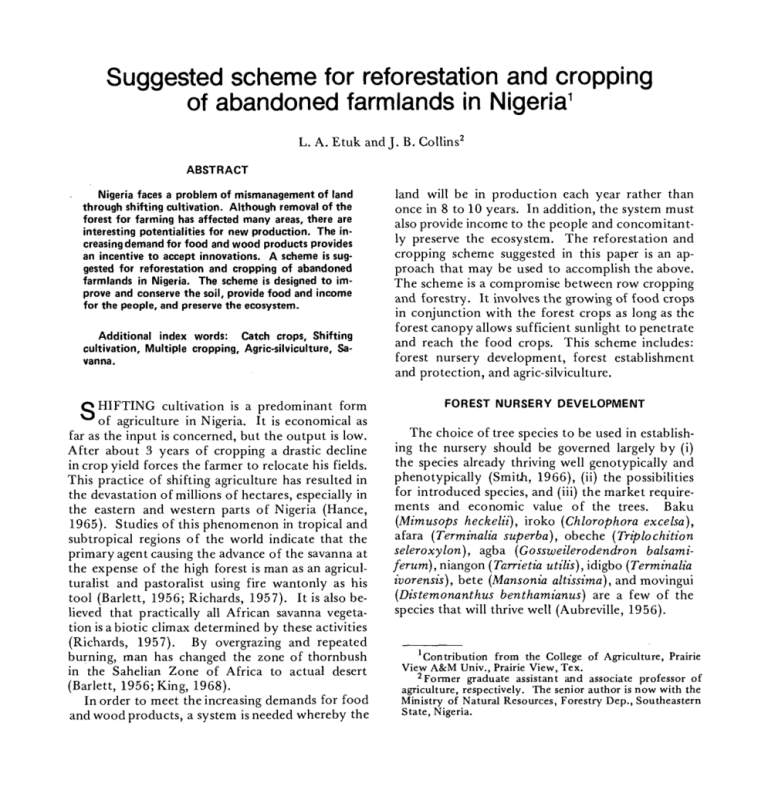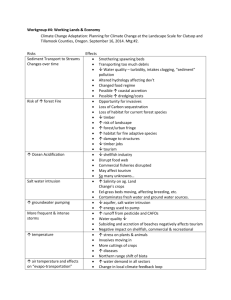Suggested Scheme for Reforestation and Cropping of Abandoned
advertisement

Suggested scheme for reforestation and cropping of abandoned farmlands in Nigeria1 L. A. Etuk and J. B. Gollins2 ABSTRACT Nigeria faces a problem of mismanagement of land through shifting cultivation. Although removal of the forest for farming has affected many areas, there are interesting potentialities for new production. The increasing demand for food and wood products provides an incentive to accept innovations. A scheme is suggested for reforestation and cropping of abandoned farmlands in Nigeria. The scheme is designed to improve and conserve the soil, provide food and income for the people, and preserve the ecosystem. Additional index words: Catch crops. Shifting cultivation. Multiple cropping, Agric-silviculture, Savanna. O HIFTING cultivation is a predominant form of agriculture in Nigeria. It is economical as far as the input is concerned, but the output is low. After about 3 years of cropping a drastic decline in crop yield forces the farmer to relocate his fields. This practice of shifting agriculture has resulted in the devastation of millions of hectares, especially in the eastern and western parts of Nigeria (Hance, 1965). Studies of this phenomenon in tropical and subtropical regions of the world indicate that the primary agent causing the advance of the savanna at the expense of the high forest is man as an agriculturalist and pastoralist using fire wantonly as his tool (Barlett, 1956; Richards, 1957). It is also believed that practically all African savanna vegetation is a biotic climax determined by these activities (Richards, 1957). By overgrazing and repeated burning, man has changed the zone of thornbush in the Sahelian Zone of Africa to actual desert (Barlett, 1956; King, 1968). In order to meet the increasing demands for food and wood products, a system is needed whereby the land will be in production each year rather than once in 8 to 10 years. In addition, the system must also provide income to the people and concomitantly preserve the ecosystem. The reforestation and cropping scheme suggested in this paper is an approach that may be used to accomplish the above. The scheme is a compromise between row cropping and forestry. It involves the growing of food crops in conjunction with the forest crops as long as the forest canopy allows sufficient sunlight to penetrate and reach the food crops. This scheme includes: forest nursery development, forest establishment and protection, and agric-silviculture. FOREST NURSERY DEVELOPMENT The choice of tree species to be used in establishing the nursery should be governed largely by (i) the species already thriving well genotypically and phenotypically (Smith, 1966), (ii) the possibilities for introduced species, and (iii) the market requirements and economic value of the trees. Baku (Mimusops heckelii), iroko (Chlorophora excelsa), afara (Terminalia superba), obeche (Triplochition seleroxylon), agba (Gossweilerodendron balsamiferum), niangon (Tarrietia utilis), idigbo (Terminalia ivorensis), bete (Mansonia altissima), and movingui (Distemonanthus benthamianus) are a few of the species that will thrive well (Aubreville, 1956). 'Contribution from the College of Agriculture, Prairie View A&M Univ., Prairie View, Tex. 2 Former graduate assistant and associate professor of agriculture, respectively. The senior author is now with the Ministry of Natural Resources, Forestry Dep., Southeastern State, Nigeria. 42 JOURNAL OF AGRONOMICEDUCATION High quality seed is necessary for a successful forest nursery. Seed should be selected during the dry season from well-formed trees growing in substantial numbers to insure cross-pollination. In general, large seeds have higher germinating power and produce larger seedlings than do small seeds (Smith, 1966). Seeds can be collected from the surface of the soil or from water surfaces, from standing or felled trees, and from animal hoards (Tourney and Korstian, 1957). With proper instruction, the seed can be collected by the children in the local village. The nursery site should be carefully selected. The best soils for nurseries are deep sandy loams, free of stones, and well or moderately well drained with a level to gently sloping topography. Sandy loams containing from 15 to 20% silt and clay particles are preferable. Coarser textured soils may be improved by the addition of organic matter or, in some cases, clay. Fine textured soils are difficult to manage and are undesirable. Soils with impermeable subsoils should be avoided. The nutrient content and pH of the soil can be adjusted by the addition of fertilizers and liming materials, respectively. Soils with pH levels higher than 6.0 favor invasion of fungus diseases and should be avoided. An organic matter content of at least 2% in the upper 15 cm will insure favorable soil-airwater relationships (Wakeley, 1954). Good air circulation will reduce the risk of injury to nursery stock from extreme temperatures (Toumey and Korstian, 1957). The site should be carefully investigated to determine whether problems with insects, funig, nematodes, or weeds are likely to be serious. In preparing the seedbed, cut and burn the natural vegetation so as to kill weed seed and harmful parasitic organisms. The seedbeds can be improved by plowing under a cover crop, such as mucuna beans. 3 The seeds should be drilled or broadcasted, just before the rainy season, on a level bed with loose soil. Width of the beds can vary from 90 to 150 cm with 15 to 30 cm between beds. The optimum average number of seedlings per 0.09 m2 varies from about 30 to 45, but can be as high as 100 depending on species and on soil fertility (Tourney and Korstian, 1957). Sowing drills instead of broadcast does not reduce the optimum number unless the drills are spaced more than 20 cm apart. Broadcast sowing produces uniform stands of seedlings and lateral development is uniform in all directions. Drills should be sown 15 cm center to center. An advantage of drill sowing over broadcast is that seedlings in drills can be sidedressed with fertilizer and cultivated. Beds must be covered to protect seed from birds and rodents, and from displacement by rain, and particularly to keep seed and soil continuously moist. The covering must allow water and some light to reach the seed. It must be nontoxic, inexpensive and easy to apply and, if need be, easy to remove. Straw and grass provide excellent cover and should be applied evenly and lightly as a mulch to a depth of 1 to 3 cm (Wakeley, 1954). During the seedling stage, a low shade is needed to protect the seedlings from direct tropical rain, sun rays, and wind. Palm fronds on wooden racks provide excellent shade, and they are readily available and relatively inexpensive. The seedlings should be thinned, weeded and watered as needed. When there is not enough rainfall, one watering (0.3 to 0.6 cm of water) per day is usually sufficient to keep the beds moist (Wakeley, 1954). One year old seedling less than 1 foot in height are recommended for planting. For windbreaks the 2 year old seedlings are preferable to the 1 year olds. The best quality of stock is that which has a relatively small top and a large root system (Show, 1930). FOREST ESTABLISHMENTAND PROTECTION In Nigeria seedlings should be planted in May, since the rainy season starts in April. At this time the soil is moist, the atmosphere ls humid and evaporation rates are at a minimum. Naked root seedlings should be hand planted with a planting bar which enables the roots of the seedlings to be set firmly at the correct depth. With a planting bar, a two-man crew can plant 1,000 to 1,500 seedlings] 8-hour working day. Competition from the natural vegetation growing on the site where the forest is to be established can be reduced or eliminated by either total clearance by cutting and burning, tractor-and-chain or agrisilviculture. Land preparation expense can be partially reclaimed if the vegetation being cleared has some commercial value such as pulpwood, firewood and charcoal. More economical and efficient use of the soil resources in Nigeria can be obtained by using the agri-silviculture method where food crops are grown in conjunction with the forest crops. A newly established forest is subjected to risks of damages caused by weather conditions, insects, fungal or viral diseases, fire, wild and domestic animals, and man. The degree of risk from any one of these will vary according to the environmental conditions at each location. These risks should be assessed during the planting stage, so that remedial measures can be taken or at least anticipated. ETUK & COLLINS: Remedial measures can be devised for protection against most of the likely damages (FAO, 1973; Smith, 1966).4 AGRIC-SILVICULTURE OPERATION To a Nigerian farmer, abandoned farmland is fallowed land upon which he will return when nature has once again restored fertility to the soil. There is concern that reforestation of abandoned farmland will bring untold hardship on the farmers. In order to sustain the people while they are waiting for the tree crops to become economically productive, agricultural crops or catch crops will be grown in conjunction with the forest crops. The tree species should be fast growing, of economic value, capable of withstanding short periods of competition from the agricultural crops for light, water and nutrients, and they should make little demands on the site. In order to reduce the possibility of root damage from the cultivators, early root system should not be profuse. Teak (Tectona grandis) is a good example of such a tree species. Catch crops should possess certain agronomic restrictions. They should not cast too much shade; they should not be climbers (except in cases where climbing will not adversely affect the trees); their nutrient requirement should not be such that they rapidly exhaust the soils; and if rhizomes, they should not have the propensity to spread rapidily and their period of development and continued production should also display features of soil improvement (such as nitrogen fixation) and soil and water conservation. The yield and quality of both the catch and tree crops can be increased by the application of innovative soil and water management programs based on minimal inputs of commercial fertilizers. Soil and water management recommendations that are at a level which minimize cost of inputs and yet provide an opportunity for a high rate of return on investment can do much toward improving the income of the farmer. The agric-silviculture method can also be used to grow products not generally associated with forestry. For an example, in Dahomey, Senegal, and the Ivory Coast, cashew (Anacardium occidentale) is grown in conjunction with agricultural crops. Corn (Zea mays L.) and sometimes cotton (Gossypium spp.) is planted between the rows of the cashew trees. The cashew is planted at a spacing of about 2 m by 4 m. This spacing minimizes the possibility of uprooting the trees or damaging their roots during cultivation and harvesting of the catch crops. In FARMLANDS IN NIGERIA 43 fact, the cultural practices which cotton require result in more vigorous growth and increased yield of the cashew (King, 1968). The farmer can depend on the catch crops for a period of 5 to 7 years, if teak is used as the forest tree species; at this time, the forest canopy will not allow sufficient sunlight to reach the catch crops. After this period, the farmer can turn to the young forest for the following products: pulpwood, poles, post, yam-stakes, charcoal, fire wood and finally timber and sawlogs. Throughout the entire operation of about 20 years, there is no period when the farmer is deprived of a reliable source of income. Hence, the reforestation and cropping scheme suggested in this paper, if well managed, will help improve and conserve the soil, and provide wood products, food, and income to the people. This scheme is much more rewarding than leaving the land to either revert to natural vegetation or suffer the effects of erosive agents. ACKNOWLEDGMENT This work is supported in part by an institutional grant under section 211(d) of the Foreign Assistance Act of 1961 as amended in 1966. The authors express their appreciation to Dorothy Davis and Linda Walker for their assistance in the preparation of the manuscript.






